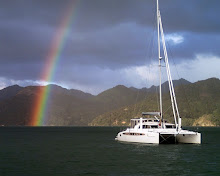Our 65 mile passage from Tahuata to the island of Ua Poa began with a
4:30am wakeup and last minute preparations for a pre-dawn departure. Once
clear of the anchorage we raised “Blue Rodeo’s” main sail and pointed the
bow toward our destination. Unfortunately, the winds remained so light
throughout most of the day that we motor-sailed the whole way. The
exception though was when we were just five miles from the rocky,
northeast shore of the island, where we were overtaken by a squall that
brought with it winds gusting to as high as 42 knots. Fortunately, as the
squall’s ominous, black cloud bore down on us, we reduced our mainsail
area to the second reef point. With the strong winds, the seas quickly
became ugly and we were relieved to finally turn the corner into the tiny
harbor of Hakahau and gain some shelter from the wind and waves. Two
other boats were already at anchor so we joined them using both bow and
stern anchors to hold our bow into the wind-driven swells that wrapped
around the harbor’s breakwater.
By the next morning, the stormy weather had passed and we were treated to
the sight of the island’s dramatic skyline punctuated by near-vertical
spires thrusting upward from the jungle-covered ridges. It was quite a
sight to watch the spires come in and out of view a clouds swirled nearby.
After a quick breakfast aboard, we launched our dinghy and went to shore
for an exploratory walk. Soon after securing our dinghy to the quay and
exiting the harbor area, we were greeted by a young woman with a huge
smile as she bicycled toward us. After asking if we spoke English, her
eyes lit up and she proceed to tell us that she was a teacher at the local
school and had lived and worked for a while in Cornwall, England where she
learned to speak English. Since it was Saturday and the school was
closed, she insisted on being our guide and accompanied us to several
markets and on a tour of the village. Mel, the young woman, was Tahitian
and was a wealth of knowledge about Polynesia. At one point it was agreed
that our group would split up so Mark could sit in front of the town’s
post office with his lap top computer to try to pick up an internet signal
while Anne would take Mel to our boat for a tour and to pick up some
shopping bags. Mark’s success with the internet was limited but made more
interesting when he was joined by three young boys who sat next to him and
watched intently what he typed onto the computer screen. They didn’t seem
that interested in his attempt to transfer money from our
retirement account but soon asked in French, mixed with a limited amount
of English, if Mark would type in a specific internet web site address.
Mark complied and up came a Japanese cartoon video site that was, no
doubt, a favorite of theirs. Even though the internet connection was too
slow to run the videos, the boys seemed grateful that Mark tried. When
Anne and Mel returned from the boat, they found Mark still sitting on the
sidewalk with the three boys snuggled up to him and staring at the
computer screen. We looked at the experience as just another example of
how quickly the world is changing and how we consider ourselves fortunate
to be seeing some of the remote parts of the South Pacific before modern
technology changes it for the worse.
The following day, we motored a short distance along the island’s north
shore to another beautiful bay passing along the way an airport with a
paved runway cut through the jungle from the shoreline up a steeply rising
valley. The rapidly rising terrain at the runway’s opposite end meant
that this was a “no go-around” airport, much like some of the airstrips
that we fly into in Idaho’s backcountry, where a landing must be made on
the first attempt. Takeoffs must be made in the opposite direction
regardless of the wind direction. Even though the island’s population in
limited in number, air service to Tahiti is available several days a week,
no doubt subsidized by the French government.
Our anchorage at Hakahetau, off another small and picturesque village,
provided a splendid place to watch the sunset and spend a relaxing
evening. The next morning, we would raise anchor and set sail for the
island of Nuku Hiva, our final Marquesan island destination before heading
southwest toward the Tuamotu Archipelago
Subscribe to:
Post Comments (Atom)

We love reading of your travels. Just bought a new 42' Beneteau, and hope to leave in a year. Thanks for the great documentary.
ReplyDelete